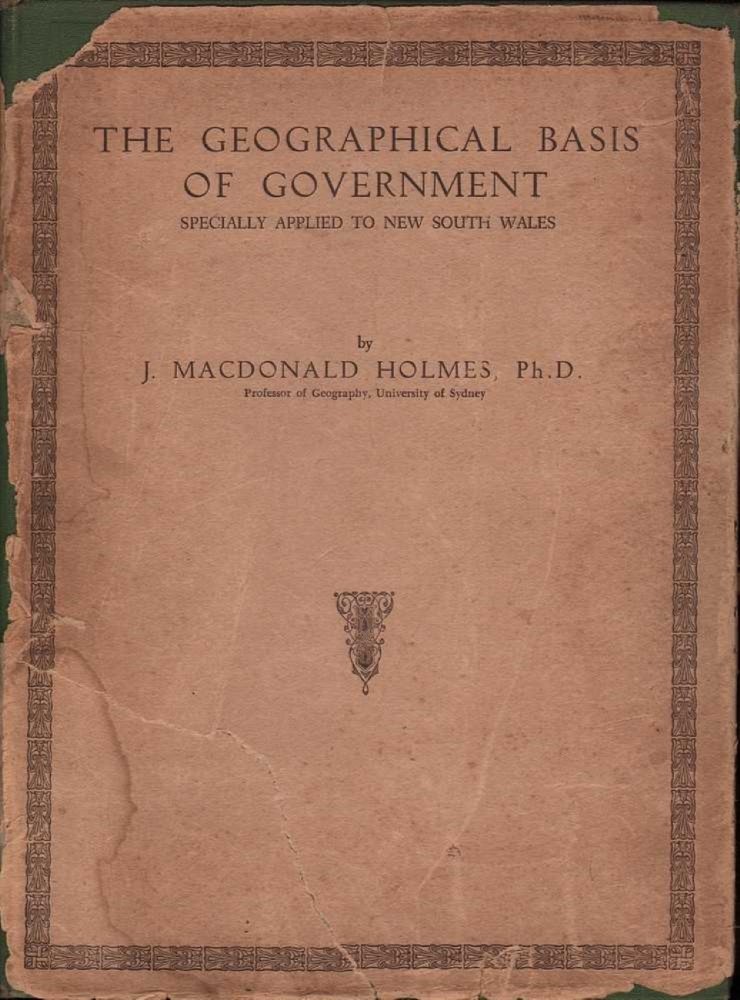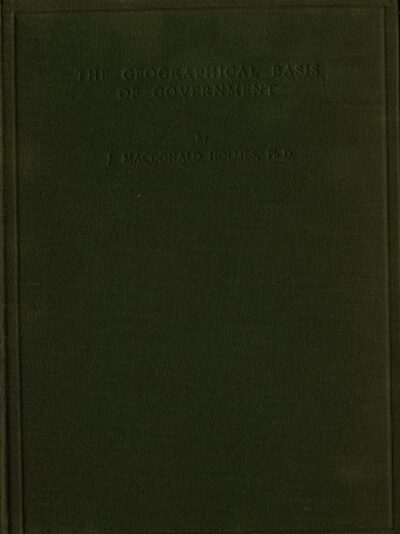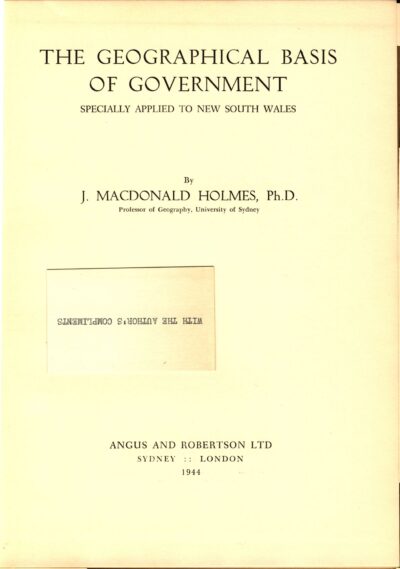J. Macdonald Holmes, The Geographical Basis of Government, specially applied to New South Wales (1944)
James Macdonald Holmes was a well-respected geographer and University of Sydney Professor whose expertise was enlisted to give academic justification to the ‘New State Movement’ – a widespread campaign for the subdivision of Australia into smaller States which supporters claimed would facilitate greater decentralisation and the development of regional areas.
Born in Renfrewshire, Scotland in 1896, Holmes served in the Royal Navy and received a certificate of distinction in geography from the University of Glasgow. Elected a fellow of the Royal Geographical Society of London in 1927, he embarked down an academic path that saw him become lecturer-in-charge of geography at Armstrong College before taking up an appointment as associate-professor of geography at the University of Sydney – for which he emigrated. There his research focused on soil erosion and regional planning, the latter of which led to him giving evidence to the Nicholas Royal Commission into the possible boundaries of New States, an experience which inspired him to produce The Geographical Basis of Government.
The book argues that the boundaries of the Australian States had been set up arbitrarily with no knowledge or appreciation of the resources of the continent, and that the Sydney-centric focus of New South Wales slowed economic and social advancement, and discouraged the growth of a semi-independent regional consciousness among nodal rural settlements. It uses a series of maps depicting the patterns of human occupation in New South Wales, including population distribution, railroads, factories, mineral out-put, and land-use characteristics, as the basis to divide the State into 48 geographic or community-of-interest regions. These the author believed should be grouped together in order to divide the territory on a more logical basis, which promised to secure better administration and higher standards of living outside of the capital.
Menzies’s copy was sent to him ‘with compliments of the author’, and it is an artefact of the strength of the New State movement in his era. The movement can be traced back as far as John Dunmore Lang, and the campaigns that successfully saw the Port Phillip District (Victoria) and Moreton Bay Region (Queensland) win independence from New South Wales in the mid 19th century. During the Federation era, many people believed that if Australia was going to reach its potential of rivalling the United States, it would need to be divided up into many States and that American success had been founded on the basis of a great degree of local autonomy. The Constitution was deliberately written up to allow for the creation of New States, and clauses like the nexus (which links the size of the House of Representatives to the size of the Senate), were clearly written with a view to having more than six States represented in the Federal Upper House. At the time of Federation Queensland in particular looked likely to divide itself up, while in Western Australia moves were afoot to create a New State out of the gold mining region (which was full of Victorians) had WA chosen not to join the Commonwealth.
One of the leaders of the New State Movement in the post-Federation era was Country Party Leader Earl Page – who even contemplated a revolutionary secession of the New England region at the height of troubles which ultimately saw Jack Lang be dismissed as Premier by the NSW Governor. Page would famously have a falling out with Menzies, which perhaps did not endear the latter to the New State cause and indeed it was not much of an issue in Victoria, considering the territory was already comparatively geographically compact. Nevertheless, during his record stint as prime minister Menzies was frequently lobbied by deputations on the issue from both NSW and Queensland.
The problem for the New State Movement was that the Constitution requires the existing States to consent to any changes in their boundaries, and therefore having support in a particular region which desires independence is not enough. This is what the New State movement lobbied Menzies over – they wanted Constitutional change to get rid of this high bar on achieving autonomy. Menzies, who knew from personal experience how difficult referendums were, was gracious towards the deputations and would speak to them, but he was not willing to invest the political capital required to meet their demands.
Even with this enduring barrier of requiring permission from the existing State, the NSW Askin Government gave New England a chance to vote on the issue at a referendum in 1967 (following a promise Askin had made as Opposition Leader to court support in the region). This poll controversially included Newcastle in the New State, and as that area did not have the same desire for independence as its northern counterparts, it ultimately tipped the scales in favour of a ‘no’ vote (which some allege was Askin’s deliberate intention). Since then, New States are a rarer discussion point, but they may well have a reemergence as high immigration levels and a housing crisis give new imperative to the push towards regional development and decentralisation.
You might also like...
Sign up to our newsletter
Sign up for our monthly newsletter to hear the latest news and receive information about upcoming events.




